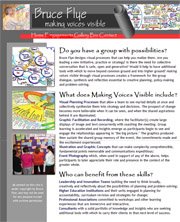To see the presentation's images, click on the Vimeo screen here.
Using this blog’s name as the title, my content went through a progression:
• Some history on how I came to be there
• Examples of work by others in our field
• A synopsis of the history of graphic recording and graphic facilitating, beginning with the work of architects
• An overview of its applications
• My own thoughts about what I’m learning
• Potential applications that would be useful to architects
There were three things that happened that were particularly enjoyable for me:
1. They agreed to participate in a short “Graphic Jam” like what we do at IFVP. They were given one minute to draw a metaphor for each word, and a few of their images are shown below.
a. Analysis
b. Bio-Diversity
c. Intrusive
d. Clean Air
e. Combos
2. They used Leadership Metaphor Explorer as a way to have images inspire conversations
3. Most of the questions asked were about finding ways to have creative conversations at a deeper level, with clients in particular. Yes, they commented on the visual tools, but their real interest seemed to be relational.
There were a couple of things heard in other sessions that got my attention, and one was from Matthew Frederick, author of 101 Things I Learned in Architecture School. He quoted Marshall Berman: “The crumbling of social relationships, not materials, turns structures into ruins.”
Most throttling of all was a conversation I had with Harry Harrison and Darin Waters about the Young Men’s Institute in Asheville. Initially conceived as an African-American YMCA during the time of the Vanderbilts, it was the resourcefulness of the almost invisible African-American communityin Asheville that made it a success. Darin described finding three letters written by his grandfather in the Vanderbilt archives, and commented that “History is about identity.” That made me twitch a bit, considering that sometimes we do not want to be constrained or pigeon-holed by the past.
Later in the talk they quoted one of the early leaders’ confidence in the face of doubts about the viability of the center: “The verdict has not been written.” That’s more the way I like to think, but I asked about the seeming conflict between the two statements. What we ultimately determined is that our histories are never final, but always works in progress.


No comments:
Post a Comment